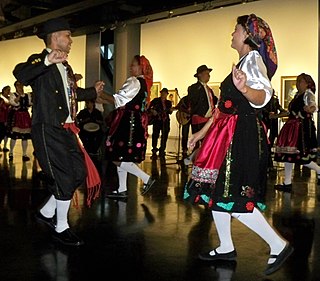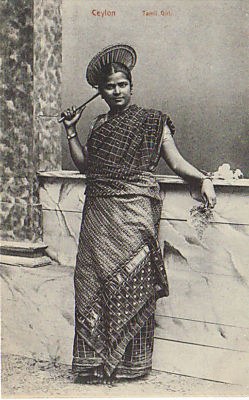Related Research Articles

Portuguese creoles are creole languages which have Portuguese as their substantial lexifier. The most widely-spoken creoles influenced by Portuguese are Cape Verdean Creole, Guinea-Bissau Creole and Papiamento.
Eurasian Singaporeans are Singaporeans of mixed European and Asian descent. Their Asian ancestry trace from Colonial India to other colonies while their European ancestry trace back to western Europe primarily, although Eurasian settlers to Singapore in the 19th century came largely from other European colonies. These included British Malaya and British Sarawak, part of the former British Raj India, of the former Portuguese India and Chittagong, the Dutch East Indies and French Indochina. When the European maritime powers colonised Asian countries, such as Colonial India, Ceylon, Malaya, Singapore, Indonesia and Indochina, from the 16th to 20th centuries, they brought into being a new group of commingled ethnicities known historically as Eurasians.

Batticaloa is a major city in the Eastern Province, Sri Lanka, and its former capital. It is the administrative capital of the Batticaloa District. The city is the seat of the Eastern University of Sri Lanka and is a major commercial centre. It is on the east coast, 111 kilometres (69 mi) south of Trincomalee, and is situated on an island. Pasikudah is a popular tourist destination situated 35 km (22 mi) northwest with beaches and flat year-round warm-water shallow-lagoons.
Burgher people, also known simply as Burghers, are a small Eurasian ethnic group in Sri Lanka descended from Portuguese, Dutch, British and other Europeans who settled in Ceylon. The Portuguese and Dutch had held some of the maritime provinces of the island for centuries before the advent of the British Empire. With the establishment of Ceylon as a crown colony at the end of the 18th century, most of those who retained close ties with the Netherlands departed. However, a significant community of Burghers remained and largely adopted the English language. During British rule, they occupied a highly important place in Sri Lankan social and economic life.
Sri Lanka Indo-Portuguese, Ceylonese Portuguese Creole or Sri Lankan Portuguese Creole (SLPC) is a language spoken in Sri Lanka. While the predominant languages of the island are Sinhala and Tamil, the interaction of the Portuguese and the Sri Lankans led to the evolution of a new language, Sri Lanka Portuguese Creole (SLPC), which flourished as a lingua franca on the island for over 350 years (16th to mid-19th centuries). SLPC continues to be spoken by an unknown number of Sri Lankans, estimated to be extremely small.
In Sri Lanka, the names Mestiços or Casados ("Married") referred to people of mixed Portuguese and Sri Lankan descent. The names can be traced back to the 16th century.

The Kristang or Serani are a creole ethnic group of people of predominantly mixed Portuguese and Malaccan descent, with substantial Dutch, British, Jewish, Malay, Chinese and Indian heritage. They are based in Malaysia and to some extent in Singapore. People of this ethnicity have, besides Portuguese, a strong Dutch heritage due to intermarriages, which is common among the Kristang. In addition, due to persecution by the Portuguese Inquisition in the region, a lot of the Jews of Malacca assimilated into the Kristang community. The creole group arose in Malacca between the 16th and 17th centuries, when the city was a port and base of the Portuguese Empire. Some descendants speak a distinctive Kristang language or Malacca Portuguese, a creole based on Portuguese. Today the government classifies them as Portuguese Eurasians.
The Sri Lankan Kaffirs are an ethnic group in Sri Lanka who are partially descended from 16th-century Portuguese traders and Bantu slaves who were brought by them to work as labourers and soldiers to fight against the Sinhala kings. They are very similar to the Zanj-descended populations in Iraq and Kuwait, and are known in Pakistan as Sheedis and in India as Siddis. The Kaffirs spoke a distinctive creole based on Portuguese, and the "Sri Lankan Kaffir language". Their cultural heritage includes the dance styles Kaffringna and Manja and their popular form of dance music Baila.
Hugh L. Nevill was a British civil servant, best known for his scholarship and studies of the culture of Sri Lanka.
The Sri Lanka Portuguese Creole Manuscript is a significant record of the Sri Lankan Indo-Portuguese creole, as spoken in the 19th century among the Burgher and Kaffir communities. It a precious source for linguistic, literary, anthropological, and folkloric studies.

Sri Lankan Tamils, also known as Ceylon Tamils or Eelam Tamils, are Tamils native to the South Asian island state of Sri Lanka. Today, they constitute a majority in the Northern Province, form the plurality in the Eastern Province and are in the minority throughout the rest of the country. 70% of Sri Lankan Tamils in Sri Lanka live in the Northern and Eastern provinces.

The Sri Lankan Tamil dialects or Ceylon Tamil or commonly in Tamil language Eelam Tamil are a group of Tamil dialects used in Sri Lanka by its native Tamil people and Eastern Moors, and Coast Veddas that is distinct from the dialects of Tamil spoken in Tamil Nadu and Sri Lanka. It is broadly categorized into three sub groups: Jaffna Tamil, Batticaloa Tamil, and Negombo Tamil dialects. But there are number of sub dialects within these broad regional dialects as well. These dialects are also used by ethnic groups other than Tamils and Moors such as Sinhalese people, Portuguese Burghers and the indigenous Coastal Vedda people.

Sri Lankan place name etymology is characterized by the linguistic and ethnic diversity of the island of Sri Lanka through the ages and the position of the country in the centre of ancient and medieval sea trade routes. While typical Sri Lankan placenames of Sinhalese origin vastly dominate, toponyms which stem from Tamil, Dutch, English, Portuguese and Arabic also exist. In the past, the many composite or hybrid place names and the juxtaposition of Sinhala and Tamil placenames reflected the coexistence of people of both language groups. Today, however, toponyms and their etymologies are a source of heated political debate in the country as part of the political struggles between the majority Sinhalese and minority Sri Lankan Tamils.

The Vanni chieftaincies or Vanni principalities was a region between Anuradhapura and Jaffna, but also extending to along the eastern coast to Panama and Yala, during the Transitional and Kandyan periods of Sri Lanka. The heavily forested land was a collection of chieftaincies of principalities that were a collective buffer zone between the Jaffna Kingdom, in the north of Sri Lanka, and the Sinhalese kingdoms in the south. Traditionally the forest regions were ruled by Vedda rulers. Later on, the emergence of these chieftaincies was a direct result of the breakdown of central authority and the collapse of the Kingdom of Polonnaruwa in the 13th century, as well as the establishment of the Jaffna Kingdom in the Jaffna Peninsula. Control of this area was taken over by dispossessed Sinhalese nobles and chiefs of the South Indian military of Māgha of Kalinga (1215–1236), whose 1215 invasion of Polonnaruwa led to the kingdom's downfall. Sinhalese chieftaincies would lay on the northern border of the Sinhalese kingdom while the Tamil chieftaincies would border the Jaffna Kingdom and the remoter areas of the eastern coast, north western coast outside of the control of either kingdom.
Vedda is an endangered language that is used by the indigenous Vedda people of Sri Lanka. Additionally, communities such as Coast Veddas and Anuradhapura Veddas who do not strictly identify as Veddas also use words from the Vedda language in part for communication during hunting and/or for religious chants, throughout the island.
African Sri Lankans, mainly the Sri Lanka Kaffirs, are a very small Ethnic group in Sri Lanka who are descendants of African mercenaries, musicians, and labourers taken to what is now Sri Lanka by Portuguese colonists during the period of Portuguese colonial rule on the island. There are currently around 1,000 African Sri Lankans. They live in pockets of communities along the island's coastal regions of Trincomalee, Batticaloa, and Negombo. The Portuguese colonists used them to fight the Ceylonese Kings.

Indo people are a Eurasian people of mixed Indonesian and European descent. Through the 16th-18th centuries, they were known by the name Mestiço. To this day, they form one of the largest Eurasian communities in the world. The early beginning of this community started with the arrival of Portuguese traders in South East Asia in the 16th century. The second large wave started with the arrival of the Dutch East India Company (VOC) employees in the 17th century and throughout the 18th century. Even though the VOC is often considered a state within a state, formal colonisation by the Dutch only commenced in the 19th century.

Afro-Asians are African communities that have been living in the Indian Subcontinent for centuries and have settled in countries such as India, Pakistan and Sri Lanka.
The Dutch Burghers are an ethnic group in Sri Lanka, of mixed Dutch, Portuguese Burghers and Sri Lankan descent. However, they are a different community when compared with Portuguese Burghers. Originally an entirely Protestant community, many Burghers today remain Christian but belong to a variety of denominations. The Dutch Burghers of Sri Lanka speak English and the local languages Sinhala and Tamil.
The Catholic Burgher Union is an organisation of Portuguese Burghers in the town of Batticaloa, Sri Lanka. In the modern era, the Union played a strong role in the preservation of the Portuguese Burgher culture, despite their economically disadvantaged position.
References
- ↑ DeVotta, Neil (2004). Blowback: Linguistic Nationalism, Institutional Decay, and Ethnic Conflict in Sri Lanka. Stanford University Press. p. 276. ISBN 9780804749244.
- ↑ "The Portuguese Burghers" (PDF). Retrieved 25 April 2019.
- ↑ Müller, J.B. "One Nation : diversity and multiculturalism" . Retrieved 24 January 2016.
- ↑ West, Barbara A. (2009). Encyclopedia of the Peoples of Asia and Oceania. Infobase Publishing. p. 1025. ISBN 9781438119137.
- ↑ McGilvray, Dennis B. (1982). Dutch Burghers and Portuguese Mechanics: Eurasian Ethnicity in Sri Lanka. Cambridge University Press.
- ↑ "History of the Dutch in Ceylon (Sri Lanka)" . Retrieved 24 January 2016.
- ↑ "The Sri Lankan Portuguese Burghers". Ceylontoday. 7 December 2014. Retrieved 30 March 2015.
- ↑ "About Sri Lankan Burghers" . Retrieved 30 March 2015.
